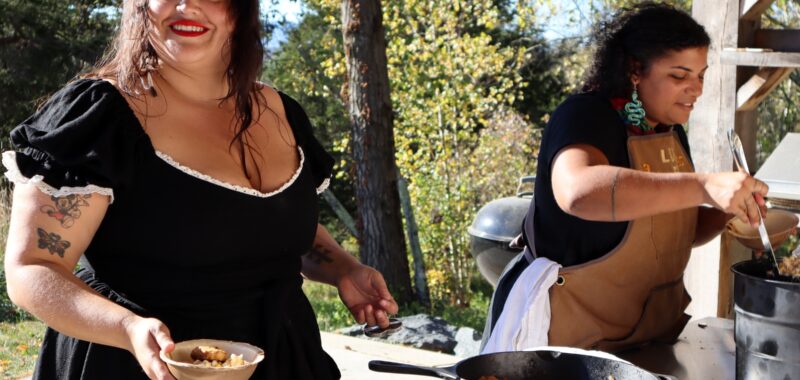TAGHKANIC, New York — Immersed in the rolling hills and fall colors of Moh-He-Con-Nuck lands, Forge Project, a Native-led nonprofit cultivating Indigenous leadership in arts and culture, welcomed the fall harvest with traditional storytelling and community gathering. Featuring chefs Brit Reed (Choctaw Descendant) and Taelor Barton (Cherokee Nation), the Autumn Table event on Saturday, October 12 was part of a series of seasonal meals programmed in collaboration with I-Collective, an autonomous group of Indigenous chefs, activists, herbalists, and seed and knowledge keepers.
Forge’s Director of Indigenous Programs and Relationality Sarah Biscarra Dilley (yaktitʸutitʸu yaktiłhini [Northern Chumash]) initiated the collaborative meal series to highlight Indigenous foodways, food sovereignty, and community-stewarded knowledge.
“The most impactful relational work happens around the table, it happens with food, it happens with an opportunity for people to come together to mark the changing seasons,” Dilley told Hyperallergic.

Hosted in an outdoor kitchen, visitors had the opportunity to witness the dance between the chefs cooking in tandem, the fire oven blazing, smoke and steam wafting in the breeze, and the hands-on Forge staff rolling up their sleeves to support everything from food prep to plating. As each course of the meal was served, Chef Barton presented the gastronomy of the traditional Southeastern dishes, narrating Native stories relating to the ingredients and demonstrating how storytelling can provide a deeper understanding of the plants, animals, and people that contributed to the creation of the shared meal.
Reed and Barton have been collaborating on meals since 2018 and wanted their menu to be a celebration of their Choctaw and Cherokee cultures. Courses this weekend included Tanchi Labona stew, fried wishi mushrooms, venison, Plum Bayou Casserole served in miniature pumpkins, catfish, bean bread wrapped in Oak and Hickory leaves, Kanuchi (a type of Cherokee pureed nut soup), and grape dumplings, just to name a few.
The Kanuchi dish in particular held a special significance for Barton, whose grandmother, Edith Knight, was known as “the Kanuchi lady” in her community and inspired Barton’s journey to become a chef.


Home was a reoccurring sentiment expressed by the organizers, cooks, and guests alike. Reed noted that Indigenous cuisine is the initial basis of regional flavors in the United States, modified over time with additions through the course of colonization.
“This is the original Southern food, so it’s no surprise that there’s so many corn elements in contemporary Southern cooking,” Reed said. “I hope this meal helps to feed visitors’ souls and bring a little bit of home to those from the Southeast. If nothing else, I want to provide more of that representation.”
The ways in which guests are welcomed play a central role in how these events come together. As hosts of many kinds of gatherings, Forge Project always offers food or drink, and guests eat first. Meals are served family-style to encourage connection and comfort, and to generate the sense that one is sharing a meal with their extended family.
Executive Director and Chief Curator Candice Hopkins (Carcross/Tagish First Nation) elaborated on this approach.
“First, we are very conscious that we are guests here on Mohican land. We also bring hosting protocols from our own communities,” she told Hyperallergic during Saturday’s meal. “These are some basic ways to take care of one another that have been forgotten in the age of museums, that are part of our values of reciprocity and how reciprocity equals different kinds of Indigenous futures.”

“It’s not just how things are harvested but how cultural knowledge nourishes us and that we experience it together,” Hopkins continued. “That hasn’t happened in this region for quite some time, at least not in a more public way, because of displacement. So part of our hosting protocols are around Indigenous placemaking and reclamation in the face of legacies of removal.”
As visitors departed, many paused to thank the chefs, exchanging stories of their own connection to these cultural foods and expressing how they would carry this experience beyond the event.
“All of this is possible because of my ancestors holding onto old foodways even after our home was moved — I have them to thank for all of this,” Barton told Hyperallergic. “I hope people leave remembering the flavors of the Southeast and the stories that may be overlooked.”




